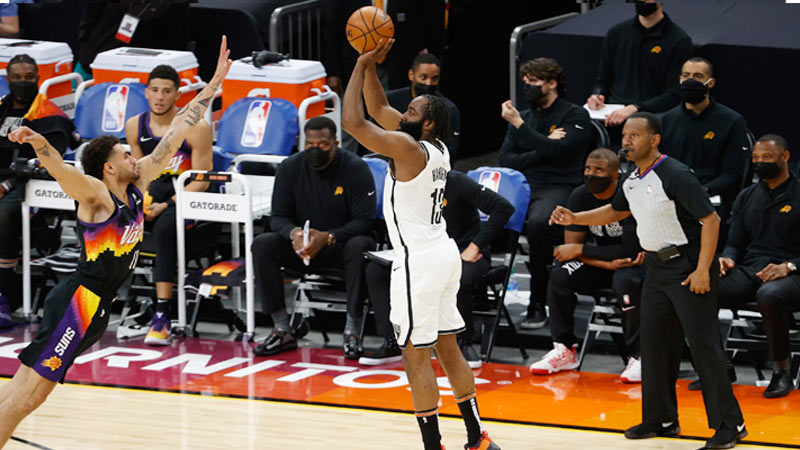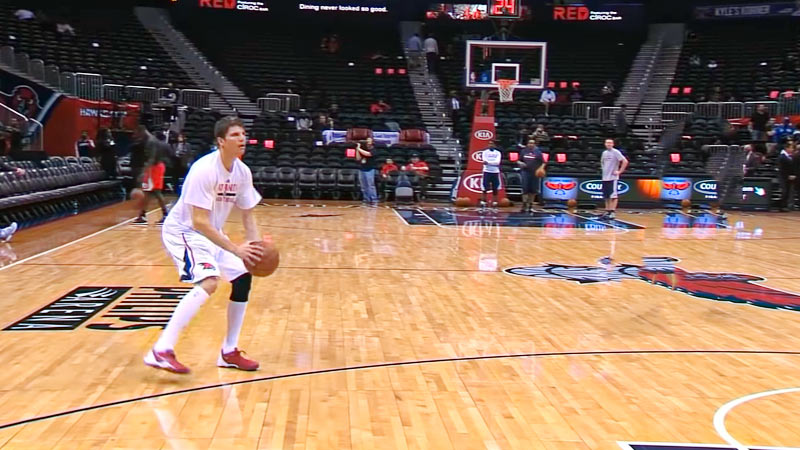Basketball, a beloved sport worldwide, has seen many changes and innovations over the years.
One of the most significant developments in the game’s history is the introduction of the three-point shot.
Before its inception, basketball relied heavily on two-point field goals, and the absence of the three-point line greatly affected gameplay strategies, scoring patterns, and the overall dynamics of the sport.
In this article, we delve into the era of basketball that existed before the three-point shot and explore how the game has transformed since its introduction. Let’s get started.
What Was Basketball Like Before the Three-Point Shot?
Basketball before the introduction of the three-point shot was a different game altogether. Prior to the 1979-80 NBA season, when the three-point line was officially implemented, teams heavily relied on two-point field goals for scoring.
In the 1978-79 NBA season, the league’s average number of three-point attempts per game was a mere 2.8, with a success rate of just 28.2%. Fast forward to the 2020-2021 season, and we see a significant shift.
Teams attempted an average of 34.9 three-pointers per game, making them at a rate of 36.7%. This statistical contrast underscores the transformative impact the three-point shot has had on the game of basketball.
Popular Players in The Time of the Three-point Shot
With the rise of the three-point shot, a new breed of players has emerged as superstars in the realm of long-range shooting.
These sharpshooters have not only redefined scoring but have also captured the imagination of fans with their awe-inspiring shooting abilities.
Let’s explore some of the prominent players who have made their mark in the era of the three-point shot.
Stephen Curry
Often regarded as the greatest shooter in NBA history, Stephen Curry has revolutionized the game with his exceptional long-range shooting skills. His ability to shoot from incredible distances with remarkable accuracy has made him a force to be reckoned with.
Curry’s unprecedented success from beyond the arc has influenced the way teams approach offense, inspiring a new era of long-range shooting.
Klay Thompson
As a member of the Golden State Warriors alongside Stephen Curry, Klay Thompson has formed one-half of the famous “Splash Brothers.” Known for his quick release and deadly accuracy, Thompson has consistently showcased his ability to score from downtown.
His performances, including a record-breaking 14 three-pointers in a single game, have solidified his reputation as one of the premier shooters in the league.
Damian Lillard
Damian Lillard, often referred to as “Dame Time,” has earned a reputation as a clutch performer and an elite long-range shooter. With his deep shooting range and ability to hit contested shots, Lillard has become a nightmare for opposing defenses.
His penchant for hitting game-winning shots from beyond the arc has made him a fan favorite and a star in the realm of the three-point shot.
Physicality in Three-Point Shots in Basketball

Source: mitchellrepublic.com
The introduction of the three-point shot not only brought changes to shooting techniques and scoring strategies but also had a significant impact on the physicality of the game.
Let’s explore how the three-point shot has influenced the physical aspects of basketball.
Altered Defensive Strategies
The presence of deadly long-range shooters has forced defenses to adapt their strategies. Defenders now have to be more aware of shooters around the perimeter, often requiring them to venture farther from the basket to contest shots.
This adjustment has opened up opportunities for drives to the rim and increased the importance of defensive rotations.
Quick Closeouts
To counter the threat of three-point shooting, defenders have to close out on shooters rapidly. Quick closeouts involve sprinting toward the shooter, forcing them to either pass the ball or take a contested shot.
This defensive technique requires agility, speed, and precise timing to disrupt the shooter’s rhythm and reduce their shooting efficiency.
Stretching the Defense
The presence of lethal three-point shooters stretches the defense horizontally, creating more spacing on the court.
As defenders are forced to guard shooters farther from the basket, it opens up driving lanes for penetrations and creates opportunities for ball movement and offensive creativity.
Increased Emphasis on Perimeter Defense
With the three-point shot becoming a dominant scoring weapon, teams now place a greater emphasis on perimeter defense.
This includes improving lateral quickness, staying disciplined in defensive rotations, and maintaining constant pressure on shooters to limit their open looks.
Fouling Concerns
Defenders must exercise caution when contesting three-point shots, as a mistimed or overly aggressive defensive play can result in fouls.
The threat of fouling three-point shooters has made defenders more mindful of their positioning and timing, requiring a balance between aggression and discipline.
What Is the Three-Point Shot in Basketball?
The three-point shot, a fundamental aspect of modern basketball, has transformed the way the game is played.
This scoring opportunity awards three points to a team if a player successfully shoots the ball from beyond the three-point line.
The three-point line is situated at a specific distance from the center of the basket and varies between different basketball leagues.
In the NBA, the line is located 23 feet 9 inches away from the basket’s center, while in college basketball, it is slightly closer at 22 feet 1.75 inches.
The implementation of the three-point shot added a new dimension to scoring, providing teams with the opportunity to secure a greater reward for shots made from long range.
History of the Three-Point Shot in Basketball

Source: hoopshabit.com
The evolution of the three-point shot was not an overnight occurrence. Its origins can be traced back to the American Basketball League (ABL) during the 1961-62 season.
The ABL experimented with a 25-foot line, rewarding three points for shots made beyond that line.
However, the ABL ceased operations in 1963, and the three-point shot was put on hold.
It wasn’t until the 1979-80 NBA season that the three-point line was officially adopted by the league.
The NBA’s decision to introduce the three-point shot was influenced by the success and popularity of the American Basketball Association (ABA), a rival league that had incorporated the three-point shot in its gameplay.
The NBA recognized the potential strategic and entertainment value of the three-point shot, leading to its inclusion.
The introduction of the three-point shot in the NBA sparked a revolution in the game. Players and teams had to adjust their strategies and skill sets to take advantage of this new scoring opportunity.
Over the years, the three-point shot has become an integral part of basketball, influencing gameplay at all levels and captivating fans with its exciting possibilities.
How the Three-Point Shot Revolutionized the NBA?
The incorporation of the three-point shot has revolutionized the NBA in various ways. Check them out below.
Influence on Scoring Strategies
The incorporation of the three-point shot has revolutionized scoring strategies in the NBA. Teams now recognize the value of three-pointers and prioritize floor spacing to create open shooting opportunities.
This has led to an increased emphasis on outside shooting, as players with exceptional shooting abilities are sought after and valued more than ever.
Coaches design offensive schemes that maximize three-point shooting, creating a dynamic and fast-paced style of play.
Transformation of Game Pace
The three-point shot has played a significant role in transforming the pace of the game. With the ability to earn three points from a single shot, teams are encouraged to push the ball up the court quickly, seeking early three-point opportunities in transition.
This has led to a more up-tempo style of play, with teams focusing on quick ball movement and rapid-fire three-point attempts to exploit defensive mismatches and capitalize on open looks.
Redefining Spacing on the Court
Floor spacing has become a key strategic element in the era of the three-point shot. The threat of long-range shooting forces defenses to stretch their coverage, creating more space in the paint for drives and facilitating better ball movement.
This emphasis on spacing has resulted in a greater emphasis on skilled perimeter players who can shoot from deep, driving the evolution of player roles and positional versatility.
Significance of Three-Point Shots in Basketball
Some of the key aspects are discussed in the following section. Please have a look at them below.
Determining Game Outcomes
The three-point shot has become a game-changer, often determining the outcome of close contests.
Teams that excel in three-point shooting have a significant advantage, as they can quickly erase deficits and build substantial leads with a few well-timed shots.
This unpredictability adds excitement and suspense to the game, making it more thrilling for both players and fans.
Empowering Underdog Teams
The three-point shot provides underdog teams with a potential equalizer against more dominant opponents. Even when facing a superior team, a hot shooting night from beyond the arc can help level the playing field and lead to surprising upsets.
This creates a sense of hope and competitiveness, making the game more inclusive and allowing for memorable underdog stories to unfold.
Showcasing Shooting Prowess
The three-point shot has given players a platform to showcase their shooting skills and prowess.
Exceptional shooters are celebrated for their ability to consistently knock down shots from long range, often becoming fan favorites and earning a reputation as “sharpshooters” or “snipers.”
This recognition not only elevates individual players but also adds an element of excitement and anticipation whenever they step on the court.
Strategic Depth
The introduction of the three-point shot has added a new layer of strategy to the game. Coaches must carefully analyze and plan their offensive schemes to maximize the efficiency of three-point opportunities.
This strategic element involves understanding the strengths and weaknesses of both the opposing defense and their own team, as well as making in-game adjustments to exploit favorable matchups and create open looks from beyond the arc.
FAQs
Why was the three-point shot introduced in basketball?
The three-point shot was introduced to encourage long-range shooting, increase scoring diversity, and enhance strategic elements in the game.
How did the three-point shot impact scoring patterns in basketball?
The three-point shot led to an increase in overall scoring, as teams could now earn three points for shots made beyond the three-point line.
Were there any notable players who excelled in shooting before the three-point shot?
Yes, players like Jerry West and Rick Barry were known for their long-range shooting abilities before the three-point shot was introduced.
Did the three-point shot receive immediate acceptance by players and fans?
The initial response to the three-point shot was mixed, with some players and fans skeptical of its significance.
However, over time, its value became evident.
How has the three-point shot influenced youth basketball and player development?
The three-point shot has influenced youth basketball by emphasizing the importance of shooting skills and encouraging players to develop their long-range shooting abilities from an early age.
Bottom Line
The three-point shot has undoubtedly left an indelible mark on the game of basketball. Its introduction transformed scoring patterns, strategic approaches, and the way the sport is played at all levels.
While basketball, before the three-point shot showcased its own unique style, the evolution of the game, has been enriched by the added dimension of long-range shooting.
As we continue to witness the impact of the three-point shot, one thing remains certain: basketball will always adapt and evolve, fueled by innovation and a desire to push the boundaries of the sport we love. Thank you so much.







